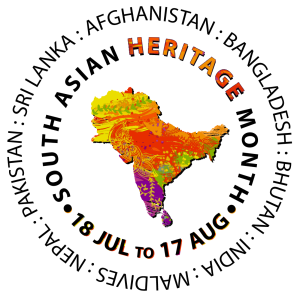South Asian Heritage Month (SAHM) first took place in 2020 and runs from the 18th of July to the 17th of August each year.
SAHM seeks to commemorate, mark and celebrate South Asian cultures, histories, and communities.
The month seeks to understand the diverse heritage and cultures that continue to link the UK with South Asia.
South Asian culture has made a significant impact on Britain in various aspects, such as food, clothing, music, words, and the overall ambiance of our towns and cities.
It’s a beautiful display of the rich and proud South Asian heritage that has blended into the British way of life, contributing to the diversity of our nation. Observing South Asian Heritage Month provides us with an excellent chance to embrace and celebrate the history and identity of British South Asians.
It’s crucial to allow people to share their own stories, and this occasion offers an opportunity to showcase what being South Asian in the 21st century entails, while also reflecting on our past and how it has shaped us.
The month begins on 18th July, the date that the Indian Independence Act 1947 gained royal assent from King George VI, and ends on the 17th August, the date that the Radcliffe Line was published in 1947, which finally set out where the border between India, West Pakistan and East Pakistan (now Bangladesh) would be.
The start and end dates show just how much of an influence Britain has had on South Asia as a whole over the last few centuries. The dates coincide to a large extent with the South Asian month of Saravan/Sawan, which is the main monsoon month when the region’s habitat undergoes renewal. Having it take place across the two Western calendar months of July and August is entirely apt, as it respects the traditions of the South Asian calendars. This period also includes several independence days connected to South Asian countries.
Afghanistan
Bangladesh
Bhutan
India
The Maldives
Nepal
Pakistan
Sri Lanka
Every single one of those countries has been hugely impacted by its relationship with Britain, primarily through war, colonisation, and ultimately via the British Empire. People of South Asian heritage are a significant part of the British population, with about 1 in every 20 people in the country being of South Asian heritage.
British India was a region of Asia that included the following present-day countries as British-governed areas or Princely States whose foreign policy was controlled by Britain:
The countries which formed British India gained independence from the British Empire in 1947.
In 1947, East Bengal was a province in Pakistan, and the province became known as East Pakistan in 1955. Bangladesh became a separate country in 1971.
The following were kingdoms or emirates whose foreign policy was controlled by Britain, but which were never part of British India:
The following were British colonies at the same time as British India:
Last year, South Asian Heritage Month was in its third year, and our theme for 2022 was Journeys of Empire.
From empires such as the Mughal, the Duranni, the Vijayanagar, and the British, from indentured labourers forced to travel to the Caribbean and East Asia, and other migrants who travelled by choice to Africa and beyond, to the journeys that families made to the UK with just £3 in their pockets, we have all been affected by the journeys of empire.
The theme also incorporated two major anniversaries taking place in 2022:
The South Asian Heritage Month team also curated a full calendar of online events for South Asian Heritage Month 2022. These 31 events over 31 days included specific Focus Days for each of the 8 countries of South Asia: Afghanistan, Bangladesh, Bhutan, India, Nepal, Pakistan, Maldives, Sri Lanka.
We encouraged everyone to organise their own events for South Asian Heritage Month. Our online calendar listed events across the UK submitted to us to celebrate, commemorate and educate about South Asian culture and histories.
2023 is all about you!
We’re excited to hear your stories! Learn more about the Theme.

The first of the Trust’s projects is the South Asian Heritage Month (SAHM), which first took place in 2020 and runs from the 18th of July to the 17th of August each year.
SAHM seeks to commemorate, mark and celebrate South Asian cultures, histories, and communities.
It seeks to understand the diverse heritage and cultures that continue to link the UK with South Asia.


© South Asian Heritage Trust | All Rights Reserved